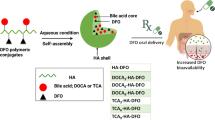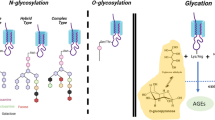Abstract
The review addresses the biochemical interactions of hyaluronidases with components of the natural microenvironment. The effect of subtle structural differences between ligands on the enzyme structure–function relationship regulation is noted. Docking of chondroitin sulfate (CS) trimers (hexasaccharides) and heparin tetramers (octasaccharides) to the 3D model of the bovine testicular hyaluronidase (BTH) was performed by computational chemistry methods in order to elucidate the mechanism of regulation of the enzyme functioning in the body (using virtual screening, molecular dynamics, and calculation of surface electrostatic potential of protein complexes). Several binding sites for glycosaminoglycan (GAG) ligands were found to occur on the hyaluronidase surface. They are identical for CS trimers and heparin tetramers. The calculations showed the possibility of both reversible and irreversible conformational changes of the 3D structure of BTH, depending on the arrangement of negatively charged ligands on its globule. When the changes are irreversible, Glu-149 and Asp-147, which are key amino acid residues for the catalytic activity of BTH, can migrate from the vicinity of the native enzyme active site to the periphery of the protein molecule, thus inducing enzyme inactivation. The interaction of the GAG ligands with the BTH active site is mainly caused by electrostatic forces. Four or five binding sites of the chondroitin sulfate trimer proved to be critical for stabilization of the enzyme structure. Their occupation was sufficient for preventing irreversible deformation of the BTH molecule upon the insertion of the heparin ligand into the active site cavity. Protein stabilization is accompanied by the formation of a particular form of the surface electrostatic potential.
Similar content being viewed by others
References
O. C. Grant, M. B. Tessier, L. Meche, L. K. Mahal, B. L. Foley, R. J. Woods, Glycobiology, 2016, 26, 772; DOI: 10.1093/glycob/cww020.
M. Agostino, N. S. Gandhi, R. L. Mancera, Glycobiology, 2014, 24,840.
N. V. Sankaranarayanan, U. R. Desai, Glycobiology, 2014, 24, 1323.
M. Jayakanthan, R. Jubendradass, S. C. D´Cruz, P. P. Mathur, Methods Mol. Biol., 2015, 1268,273.
A. Maksimenko, A. Turashev, A. Fedorovich, A. Rogoza, E. Tischenko, J. Life Sci., 2013, 7,171.
A. V. Maksimenko, A. D. Turashev, R. S. Beabealashvili, Biochemistry (Moscow), 2015, 80,284.
K. L. Chao, L. Muthukumar, O. Herzberg, Biochemistry, 2007, 46, 6911.
K. S. Girish, K. Kemparaju, Biochemistry (Moscow), 2005, 70,948.
T. Honda, T. Kaneiwa, S. Mizumoto, K. Sugahara, S. Yamada, Biomolecules, 2012, 2,549.
F. Zhang, B. Walcott, D. Zhou, A. Gustchina, Y. Lasanajak, D. F. Smith, R. S. Fereira, M. T. S. Correia, P. M. G. Paiva, N. V. Bovin, A. Wlodawer, M. L. V. Oliva, R. J. Linhardt, Biochemistry, 2013, 52, 2148.
V. K. Yadav, R. S. Mandal, B. L. Puniya, R. Kumar, S. Day, S. Singh, S. Yadav, Chem. Biol., Drug Des., 2015, 85,404.
N. S. Gandhi, C. Freeman, C. R. Parish, R. L. Mancera, Glycobiology, 2012, 22,35.
G. Jug, M. Anderluh, T. Tomasic, J. Mol. Model., 2015, 21, 164; DOI: 10.1007/s00894-015-2713-2.
S. A. Samsonov, Y. Teyra, M. T. Pisabarro, J. Comput. Aided Mol. Des., 2011, 25,477.
S. A. Samsonov, M. T. Pisabarro, Glycobiology, 2016, 26,850.
L. Ballut, N. Sapay, E. Chautard, A. Imberty, S. Ricard-Blum, J. Mol. Recognit., 2013, 26,76.
Y. Tatara, I. Kakizaki, S. Suto, H. Ishioka, M. Negishi, M. Endo, Glycobiology, 2015, 25, 557; DOI: 10.1093/glycob/ cwu186.
A. V. Maksimenko, Khim.-Farm. Zh. [Chem. Pharm. J.], 2008, 42, No. 10, 3 (in Russian).
A. V. Maksimenko, R. Sh. Beabealashvili, Kardiol. Vestnik [Bull. Cardiol.], 2016, XI, 70 (in Russian).
S. Batool, S. Ferdous, M. A. Kamal, H. Iftikhar, S. Rashid, Enz. Eng., 2013, 2, 1; DOI: 10.4172/eeg.1000106.
A. V. Maksimenko, Russ. Chem. Bull. (Int. Ed.), 2015, 64, 2036.
E. F. Pettersen, T. D. Goddard, C. C. Huang, G. S. Couch, D. M. Greenblatt, E. C. Meng, T. E. Ferrin, J. Comput. Chem., 2004, 25, 1605.
M. F. Sanner, A. J. Olson, J. C. Spehner, Biopolymers, 1996, 38,305.
P. T. Lang, S. R. Brozell, S. Mukherjee, E. F. Pettersen, E. C. Meng, V. Thomas, R. C. Rizzo, D. A. Case, T. L. James, I. D. Kuntz, RNA, 2009, 15, 1219.
T. J. Dolinsky, P. Czodrowski, H. Li, J. E. Nielsen, J. H. Jensen, G. Klebe, N. A. Baker, Nucleic Acids Res., 2007, 35, W522.
T. J. Dolinsky, J. E. Nielsen, J. A. McCammon, N. A. Baker, Nucleic Acids Res., 2004, 32, W665.
N. A. Baker, D. Sept, S. Joseph, M. J. Holst, J. A. McCammon, Proc. Natl. Acad. Sci. USA, 2001, 98, 10037.
B. Honig, A. Nicholls, Science, 1995, 268, 1144.
A. Nicholls, K. Sharp, B. Honig, Proteins, 1991, 11,281.
I. Klapper, R. Hagstrom, R. Fine, B. Honig, Proteins, 1986, 1,47.
N. Guex, M. C. Peitsch, Electrophoresis, 1997, 18, 2714.
J. C. Phillips, R. Braun, W. Wang, J. Gumbart, E. Tajkhorshid, E. Villa, C. Chipot, R. D. Skeel, L. Kale, K. Schulten, J. Comput. Chem., 2005, 26, 1781.
R. Concu, G. Podda, E. Uriarte, H. Gonzalez-Diaz, J. Comp. Chem., 2009, 30, 1510.
J. Batra, H. Tjong, H.-X. Zhou, Prot. Eng. Des. Sel., 2016, 29,301.
S. Sakkiah, M. Arooj, M. R. Kumar, S. H. Eom, K. W. Lee, PLoS One, 2013, 8, e51429; DOI: 10.1371/journal. pone.0051429.
B. Wang, L. Li, T. D. Hurley, S.O. Meroneh, J. Chem. Inf. Model., 2013, 53, 2659.
Author information
Authors and Affiliations
Corresponding author
Additional information
Dedicated to the memory of Academician of the Russian Academy of Sciences N. S. Zefirov.
Published in Russian in Izvestiya Akademii Nauk. Seriya Khimicheskaya, No. 4, pp. 0636–0646, April, 2018.
Based on materials of the III Interdisciplinary Symposium on Medicinal, Organic, and Biological Chemistry and Pharmaceutics (MOBI-KhimFarma 2017; May 28–31, 2017; Sevastopol, Russia).
Rights and permissions
About this article
Cite this article
Maksimenko, A.V., Beabealashvili, R.S. Effect of the hyaluronidase microe nvironment on the enzyme structure–function relationship and computational study of the in silico molecular docking of chondroitin sulfate and heparin short fragments to hyaluronidase. Russ Chem Bull 67, 636–646 (2018). https://doi.org/10.1007/s11172-018-2117-4
Received:
Revised:
Accepted:
Published:
Issue Date:
DOI: https://doi.org/10.1007/s11172-018-2117-4




